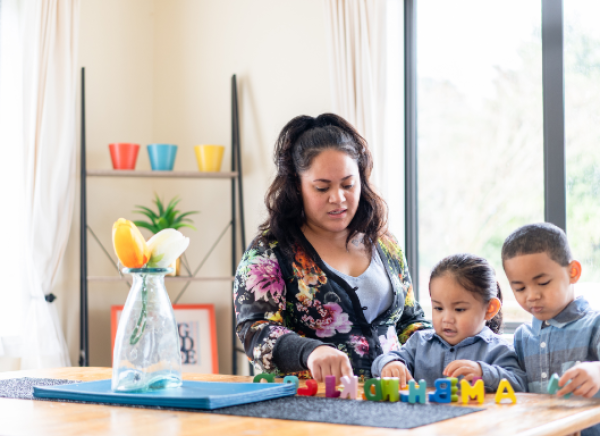Wishing everyone a safe and happy Christmas and New Year – Meri Kirihimete from the Healthify team.
Abdominal pain in children – chronic
Ongoing tummy pain in children
Key points about chronic tummy pain in children
- Chronic tummy pain is common in children.
- This is tummy pain that comes and goes for more then 2 months, and is bad enough to stop your child from doing their normal activities
- Sometimes there's an underlying condition that causes chronic tummy pain, but in most tamariki there's no serious cause found.
- It can be related to anxiety or stress in your child's life.
- If it's not managed, chronic tummy pain can affect your child's wellbeing.

Chronic tummy (abdominal) pain in children is common. It refers to tummy pain that comes and goes for more than 2 months, that’s bad enough to stop your child from doing their normal activities.
It’s often due to constipation or other problems with how your child’s gut works, or it could be related to anxiety or stress in your child’s life.
In most cases, there’s no serious underlying disease and your child is well between attacks. The pain usually improves with reassurance from your child’s healthcare provider, and family and school support if needed.

Image credit: Depositphotos
Chronic tummy pain can be vague and is usually located around the belly button. Your child may also have other symptoms such as:
- nausea (feeling sick)
- headache
- dizziness
- indigestion
- change in bowel habits, such as diarrhoea (runny poo)
- excessive gas.
In most cases (when the recurrent pain isn't due to an underlying condition), your child will be well and eating and drinking normally between attacks.
Tell your healthcare provider if your child has any of the following, as it might mean there's an underlying condition causing the tummy pain:
- Poor growth.
- Weight loss or slow weight gain.
- Changes in bowel habit – severe diarrhoea (runny poo) or constipation (not pooing enough).
- Blood in their poo or when wiping their bottom.
- Unexplained fevers, joint aches or mouth ulcers.
- Vomiting (being sick) often.
- Waking up at night due to the pain.
- Being very thirsty, peeing a lot or having pain when peeing.
- Delayed puberty.
- Family history of peptic ulcers or inflammatory bowel disease.
Often, a cause for your child’s tummy pain isn’t found, but this doesn’t mean that their pain isn’t real.
Common causes of chronic tummy pain in children include:
- constipation – hard poo that's difficult to get out and passing poo less often than usual
- recurrent abdominal pain of childhood – tummy pain without an underlying physical cause
- irritable bowel syndrome – tummy pain with diarrhoea (runny poo) or constipation
- indigestion or gastro-oesophageal reflux.
Less common causes include:
- abdominal migraine – tummy pain with nausea/vomiting, loss of appetite and pale skin
- recurrent urinary tract infections
- inflammatory bowel disease – Crohn's disease or ulcerative colitis
- coeliac disease
- gut infection, such as giardia
- food hypersensitivity, such as lactose intolerance.
There are parts of the brain that receive pain signals from damaged parts of the body, but they can also receive messages from the thinking and emotional parts of the brain. We know that these parts of the brain affect how we feel pain or even create it.
Things that can increase the chance of your child having chronic tummy pain where there is no underlying physical damage include:
- a family history of similar disorders, eg, irritable bowel syndrome
- stress and anxiety, which can make the pain worse
- depression
- food allergies or intolerances, which might trigger symptoms in some children.
There are many other causes of abdominal pain in tamariki which are rare. Your healthcare provider will discuss them with your whānau if they seem possible.
Your healthcare provider will explore your child’s symptoms to rule out all serious causes of tummy pain that seem possible.
They will ask you and your child about the tummy pain, including questions about where the pain is, what it feels like, what makes it better or worse, and whether there are any other symptoms. Read about how to describe the type of pain and describing where pain is. They will also ask if there’s a family history of illnesses such as irritable bowel syndrome or inflammatory bowel disease.
Your healthcare provider will also want to know about how your child has been at school and at home, including their behaviour and mental well-being. Children with recurrent tummy pain are sometimes worried (anxious), sad or depressed.
They’ll examine your child's tummy and measure their growth. Your healthcare provider will also ask for some tests, such as blood tests, a stool (poo) sample, a urine (pee) test or an abdominal ultrasound. These are done to rule out different causes depending on what your healthcare provider thinks is causing the pain. If underlying conditions are ruled out, your child may be diagnosed with functional or recurrent abdominal pain.
If there’s an underlying condition causing your child’s tummy pain, your child will be treated for this. If no underlying condition is found, your healthcare provider will be able to reassure you and your child that even though your child’s pain is real, it’s not caused by a serious disease and it won’t cause long-term damage.
There are many things you can do to help manage your child’s chronic tummy pain. Medicines aren’t usually needed, unless the pain is caused by an underlying condition.
Cognitive behavioural therapy or counselling from a psychologist can be helpful, for example if your child is anxious, sad or depressed or is experiencing stress related to their home or school life.
There are things you can do to help manage your child’s chronic tummy pain:
- Encourage healthy behaviours such as a balanced diet (with enough fibre, fruit and vegetables) and physical activity.
- Make sure your child drinks enough water so they don’t get dehydrated.
- Avoid reinforcing pain behaviour by giving it your attention. Use distraction instead.
- Let your child know that their pain will improve and encourage them to continue their normal activities.
- Encourage your child to go to school. Chronic tummy pain usually happens in the morning and lasts less than an hour, so take your child to school when the pain starts to settle.
- Encourage good sleep habits as poor sleep can make symptoms worse. Read about sleep and relaxation tips(external link) for children.
- Talk to your child’s teachers and discuss a plan to manage your child’s tummy pain in school.
- If you can, talk to your child to see if there’s anything that’s causing them to feel worried or stressed. Common things that cause stress in children include how they’re doing at school, bullying, friendships, worries/changes at home, their appearance, or a family illness. If your child has any worries that are causing them to feel stressed, talk with them or with their healthcare provider or teachers to find ways to help them overcome these.

Image credit: Canva
Your healthcare provider will also ask you and your child to come to regular follow-up appointments to make sure that your child's pain is settling. If your child's pain gets worse or new symptoms appear, tell your healthcare provider as this may mean that there’s an underlying condition causing your child’s tummy pain.
Apps reviewed by Healthify
You may find it useful to look at some pain management apps.
Chronic tummy pain is common in children. Most children with chronic tummy pain don’t have a serious underlying condition. Having a supportive home and school environment makes it easier for your child to cope with the pain.
Recurrent tummy pain is more likely to be ongoing if your child has had it for a long time (more than 6 months) before they see a healthcare provider. It can also be more likely to continue if parents are very stressed, or families experience lots of stressful life events.
Serious underlying conditions generally show themselves quickly because they get worse and because they show signs that alert your healthcare provider that there may be a physical cause for the pain. See the symptoms of chronic tummy pain in children above.
Recurrent abdominal pain in children(external link) Patient, UK
Chronic abdominal pain(external link) Children's Hospital Colorado
Abdominal pain(external link) The Royal Melbourne Children's Hospital, Australia
Brochures
Functional abdominal (tummy) pain disorders(external link) Guy’s and St Thomas’ NHS Foundation Trust, UK, 2021
Abdominal pain(external link) The Royal Children's Hospital Melbourne, Australia, 2018
Apps
References
- Chronic abdominal pain in children and youth(external link) Auckland Community HealthPathways, NZ, 2023
- Non-acute abdominal pain in childhood(external link) Starship Clinical Guidelines, NZ, 2012
- Recurrent abdominal pain in children(external link) Patient, UK, 2023
- Functional abdominal (tummy) pain disorders(external link) Guy’s and St Thomas’ NHS Foundation Trust, UK, 2021
- Reust CE, Williams A. Recurrent abdominal pain in children(external link) Am Fam Phys. 2018;97(12):785–793
- Abdominal pain(external link) The Royal Children’s Hospital Melbourne, Australia, 2018
- Walker, Lynn et al. Parent attention vs distraction – impact on symptoms complaints by children with and without functional abdominal pain(external link) Pain 2006;122(1–2):45–52
Clinical guidelines
Rome IV diagnostic criteria for child functional abdominal pain(external link) MD Calc, US
Non-acute abdominal pain in childhood(external link) Starship, NZ
Continuing professional development
1. PHARMAC seminar: Child health and immunisation update 1 of 3 - Functional GI disorders – Dr Anne Tait (29 minutes)
(PHARMAC seminars, NZ, 2019)
2. PHARMAC seminar: Child health and immunisation update 2 of 3 - Chronic pain (parts 1, 2 & 3) – Dr Anne Tait (31 minutes +28 minutes + 18 minutes = 77 minutes)
(PHARMAC seminars, NZ, 2019)
PHARMAC seminar: Child health and immunisation update 2b of 3
(PHARMAC seminars, NZ, 2019)
PHARMAC seminar: Child health and immunisation update 2c of 3
(PHARMAC seminars, NZ, 2019)
For more videos of the same series, visit PHARMAC seminars(external link).
Credits: Healthify editorial team. Healthify is brought to you by Health Navigator Charitable Trust.
Reviewed by: Dr Emma Dunning, Clinical Editor and Advisor
Last reviewed:





